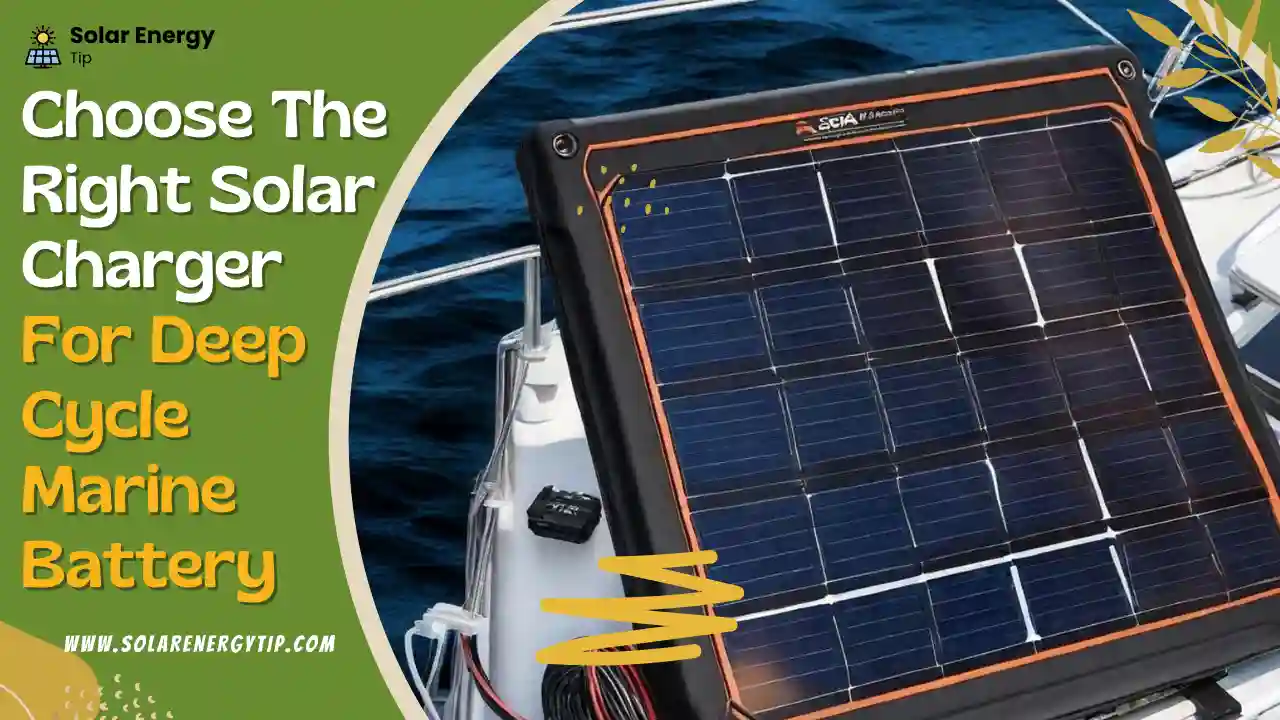If you have a boat, you want to recharge your boat’s deep cycle battery. For this recharge process, you want to use a solar charger for all time in the water.
This article will describe the many types of solar chargers for deep-cycle marine batteries and how to utilize them most effectively.
Solar battery chargers for deep-cycle marine batteries are becoming more and more common, according to the US Department of Energy.
We’re here to help if you’re looking for a solar battery charger and are unsure which one is best for your deep-cycle marine battery.
- Solar Charger For Deep Cycle Marine Battery – The Right Choice For Your Boat
- What Is A Deep Cycle Marine Battery?
- What are the benefits of solar battery chargers for deep-cycle marine batteries?
- How Do They Work?
- What Are The Advantages And Disadvantages of Solar Chargers for Marine Batteries?
- What Are The Different Types of Solar Chargers for Deep Cycle Marine Battery?
- Things to keep in mind while buying The Right Solar Charger For Deep Cycle Marine Battery
- FAQs
- Conclusion
Solar Charger For Deep Cycle Marine Battery – The Right Choice For Your Boat
Deep-cycle marine batteries can be powered by solar battery chargers, which are also helpful in properly charging them.
They offer a consistent, sustainable, and clean energy source that may be utilized to refuel a wide range of batteries and other electronic equipment.
Solar chargers are becoming increasingly effective and economical for users of deep-cycle marine batteries because of advances in solar technology.
These days, many kinds of solar battery chargers are available, and each has certain qualities that make them suited for particular uses.
Here, I recommend a decent solar charger for deep-cycle marine batteries if you don’t have time to read my lengthy post.
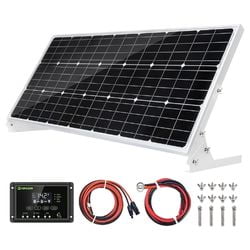
Top solar Solar Panel Kit Battery Charger
For Deep Cycle Battery
- Easy to carry and install
- Aluminum frame
- Tempered glass coating shield
- Monocrystalline Silicon
There are some things to consider when choosing the perfect solar charger. We are going to discuss it.
What Is A Deep Cycle Marine Battery?
A deep-cycle marine battery is made to give boats on the water steady, long-lasting electricity.
It is made to be repeatedly discharged and recharged and has a bigger capacity than a regular automotive battery.
This makes it the perfect option for powering onboard devices like electric motors, lighting, and boat radio systems.
Deep-cycle marine batteries can now be charged effectively and affordably using solar chargers, which helps reduce spending and provide dependable power for longer periods.
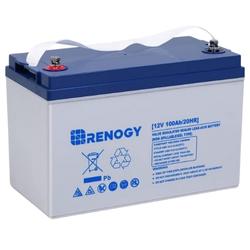
Renogy 12V 100AH
Deep Cycle Hybrid Gel Battery
- No Maintenance
- Leakage Free
- Longer Shelf Life
What are the benefits of solar battery chargers for deep-cycle marine batteries?
There are many benefits to using a Solar Charger For Deep Cycle Marine Battery, some of which include the following:
- Reduced Operating Costs: A solar battery charger can significantly reduce your vessel’s operating costs.
- Efficient: Solar chargers are some of the most efficient methods for charging batteries and work well with deep-cycle marine batteries.
- Sustainable: Solar chargers use renewable energy sources to generate power, which is good for the environment.
- Reliable: Solar chargers are reliable and perform consistently regardless of weather conditions.
How Do They Work?
Solar charger for deep cycle marine battery is designed to provide a reliable and efficient charging system powered by the sun’s energy.
These chargers are typically composed of solar panels mounted on the boat and connected to the battery.
The panels convert solar energy into electricity, then are stored in the battery. When ready to use the battery, you plug in the charger and enjoy the sun’s power.
This electricity can then power various marine equipment and accessories while at sea.
Solar chargers are an eco-friendly and cost-effective way to ensure your deep-cycle marine battery is always charged and ready for use.
What Are The Advantages And Disadvantages of Solar Chargers for Marine Batteries?
We should weigh the following benefits and drawbacks of using a solar charger on a boat to recharge a deep-cycle marine battery:
Advantages
- Since it doesn’t release greenhouse gases or other harmful substances, it is a green method of charging marine batteries.
- They are suitable for use in distant areas cut off from the power grid.
- They can produce power with enough light even when the sun is not shining.
- Due to the lack of moving parts that need to be replaced over time, they require comparatively little maintenance.
Disadvantages
- Both are purchased and installing them might be costly.
- Deep-cycle marine batteries cannot be fully charged by them, especially in cloudy or overcast weather.
- They cannot generate enough electricity to run substantial machinery or appliances.
- They can need extra hardware, including charge controllers and inverters, raising the system’s overall cost.
What Are The Different Types of Solar Chargers for Deep Cycle Marine Battery?
Here the list of solar chargers for charge the battery.
- Monocrystalline Solar Panel
- Polycrystalline Solar Panel
- Flexible Solar Panel
- Portable Solar Panel
- Foldable Solar Panel
- Trickle Solar Chargers
- Float Chargers
- Boost Charger
Now, we are going to get detailed information about each of these types of solar chargers that are capable of charging deep-cycle marine batteries.
1. Monocrystalline Solar Panel
Available monocrystalline solar panels are currently used in deep-cycle marine battery solar chargers.
Because it produces more power per square foot than any other technology, it is ideal for direct current uses like recharging batteries.
Monocrystalline solar panels are incredibly effective and can produce much solar energy in a small area.
Users who need to charge their marine batteries in small boats or confined locations will find it suitable.
Benefits and features of Monocrystalline solar panels
- Monocrystalline solar panels are a popular option for boat usage due to their high efficiency and durability.
- They are suitable for usage in regions with limited space or where the available sunlight is weak since they can convert a significant portion of sunlight into energy.
- One of its key benefits is the longevity of monocrystalline solar panels for use on boats.
- They are a good option for difficult marine situations since they can tolerate extreme temperatures, powerful winds, and large waves.
Overall, monocrystalline solar panels are a reliable and efficient choice for charging batteries on boats and can help extend your time on the water by providing a reliable power source.
I am giving you the names of some monocrystalline solar panels you can take for your boat battery, which are as follows.

Top solar Solar Panel Kit Battery Charger
For Deep Cycle Battery
- Easy to carry and install
- Aluminum frame
- Tempered glass coating shield
- Monocrystalline Silicon
2. Polycrystalline Solar Panel
Polycrystalline solar panels are also suitable for powering deep-cycle marine batteries.
The panel is perfect for marine situations because it is made to withstand the worst external conditions.
The panels charge 10–20 times faster than existing solar chargers and are also very efficient.
Polycrystalline solar panels are a fantastic option for anyone wishing to power their deep-cycle marine batteries due to their beautiful design and simplicity of installation.
Benefits and features of Polycrystalline solar panels
- Multiple silicon crystal structures are used to make polycrystalline solar panels. They are renowned for being more economical than monocrystalline solar panels and having modest efficiency.
- The cost difference between polycrystalline and monocrystalline solar panels makes them more affordable for boat installation.
- They are usually less expensive to manufacture, making them a more cost-effective choice for people on a tight budget.
- Solar panels made of polycrystalline material are robust and resistant to harsh marine environments.
Overall, polycrystalline solar panels can be a good choice for charging batteries on a boat, especially if you’re looking for a more reasonable option.
I am showing you the polycrystalline solar panel below, which is perfect for you.
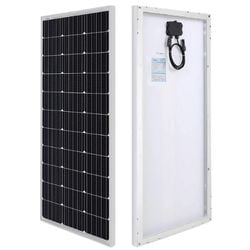
HQST 100 Watt Polycrystalline Module
PV Power for Battery Charging Boat
- High Efficiency
- Durable
- Polycrystalline Silicon
3. Flexible solar panel
Recently, a solar charger with a flexible solar panel design for deep-cycle marine batteries was introduced.
This ground-breaking revolutionary charger, which combines durability and portability in its design, might completely alter how we charge deep-cycle marine batteries.
Specification and Benefits of Flexible solar panels
- It has a unique design.
- They can be easily mounted on the roof or other boat surfaces and bent or shaped to fit close obstructions or tight spaces.
- Capable of harvesting more energy from the sun than conventional solar panels.
- Thin, lightweight panels that are flexible and designed to conform to curved or irregular surfaces.
- Flexible solar panels are also relatively durable and can withstand harsh marine environments.
Note: However, Flexible Solar Panels are generally less efficient than conventional solar panels and may not be the best choice for use in areas with limited space or low levels of sunlight.
Overall, flexible solar panels can be a good choice for charging batteries on a boat, especially if you’re looking for a lightweight and flexible option that’s easy to install.
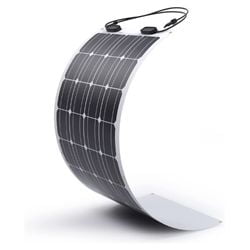
Renogy Flexible Solar Panel
100 Watt 12 Volt
- Too Flexible
- Ultra Lightweight
- Super Thin Lamination
4. Portable solar panel
A brand-new portable solar panel that works with marine deep-cycle batteries has been made available. This solar charger is portable, light, and simple to attach to marine batteries.
The solar panel’s cutting-edge technology enables it to continuously supply electricity to the battery, ensuring that your boat remains operational even while it is out on the open sea.
Maintaining the peak performance of your marine battery is easy with this solar charger.
Specification and Benefits of Portable solar panels
- They are small, lightweight solar panels that are portable and easy to carry.
- They are often used in portable solar power systems or in small boats or RVs and can be a good choice for charging deep-cycle marine batteries on boats.
- One of the advantages of portable solar panels is their convenience and portability.
- Portable solar panels are also relatively durable and can withstand harsh marine environments.
Overall, portable solar panels can be a good choice for charging batteries on a boat, especially if you’re looking for a convenient and portable option that’s easy to set up.
5. Foldable solar panel
The foldable solar panel charger is the most recent product to enter the deep-cycle marine battery industry.
This ground-breaking device is ideal for sailors who want to conserve space on their ships because it is made to fold up quickly and fit in small spaces.
With its simple setup and effective charging capabilities, this new solar panel charger will cause a stir in the marine battery charging sector.
Specification and Benefits of Foldable solar panels
- A solar panel charger can charge Most marine battery sizes rapidly and effectively without an electrical outlet.
- Solar panels may also be utilized in all types of weather because they are waterproof by design.
- Foldable solar panels are made to be compacted for simple transportation and storage.
- The simplicity and portability of foldable solar panels are one of their benefits.
- Additionally, foldable solar panels are relatively robust and resistant to harsh sea environments.
However, they are generally less efficient than conventional solar panels and may not be the best choice for use in areas with limited space or low levels of sunlight.
Overall, foldable solar panels can be a good choice for charging batteries on a boat, especially if you’re looking for a convenient and portable option that’s easy to store when not in use.
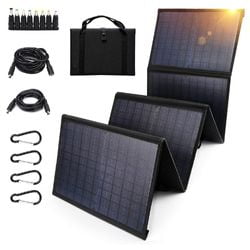
Keshoyal Foldable Solar Panel
60W Portable Solar Panels
- Too Flexible
- Ultra Lightweight
- Super Thin Lamination
6. Trickle Solar Chargers
Deep-cycle marine batteries are charged with trickle chargers because they can deliver a slow, constant charge with little chance of overcharging.
Deep-cycle marine batteries can be replaced with solar chargers because they are an electricity-free, ecologically good solution.
Specification and Benefits of Trickle solar panels
- Solar chargers are designed to be weatherproof and can be used in any environment, making them the best choice for those who want to use their chargers in a variety of locations.
- Solar chargers are also low maintenance and require minimal effort to keep them running.
- A trickle charger is a low-voltage charger designed to charge a battery over a long period gradually.
- One of the advantages of trickle chargers is that they are easy to use and require minimal maintenance.
- Trickle chargers are also relatively inexpensive and can be a cost-effective way to maintain a charge on a battery.
However, they are generally less efficient than larger, more powerful chargers. There may be better choices for charging heavily discharged batteries or for use in areas with limited space or low levels of sunlight.
Overall, A trickle charger can be a good option for maintaining charge on a deep cycle marine battery on a boat. Still, there may be better options for quickly charging a heavily discharged battery.
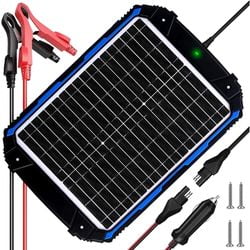
SUNER POWER Waterproof Trickle Charger
For Deep Cycle Marine Boat
- Portable & Charge Anywhere
- Intelligent Charge & Maintain
- Upgraded Visual Monitor
- Waterproof & Hign Quality Materials
7. Float Solar Chargers
Float chargers are an excellent choice for deep-cycle marine batteries, as batteries can maintain optimal charge levels without the risk of overcharging.
Float chargers are designed to charge batteries slowly and steadily and can be connected without battery damage.
This makes them ideal for powering solar chargers. It will be ensured that it remains the same.
Specification of Float solar panels
- Float or maintenance chargers are designed to maintain the charge when batteries are used.
- They often prevent batteries from being discharged too deeply, thus shortening battery damage and life.
- Float chargers are commonly used for batteries in storage or not frequently used.
- The float charger maintains charge with a low, constant current flow to the battery.
- Float chargers for use on a boat can be an excellent option to maintain the charge on a deep cycle marine battery when the boat is not in use.
Float chargers can be a good option for keeping a charge on a boat’s deep-cycle marine battery, especially when the boat is not in use for long periods. They can help extend the battery’s life by preventing it from being discharged too deeply.
8. Boost Solar Chargers
Your deep-cycle marine battery will function at its best if you use the new solar charger from Boost Technology.
Regardless of the climate or time of day, this innovative charger is intended to keep your battery charged.
You can change the current and voltage settings to meet your needs to change the charging pace.
Specification of Boost solar panels
- Solar chargers also have protective features that guard against overcharging and help save energy.
- With this reliable and efficient solar charger, you can be sure that your deep-cycle marine battery will always be ready to use.
- A boost charger, a jump starter, is a portable device designed to charge a dead or discharged battery quickly.
- Often, it has a built-in battery that is charged using a wall outlet or car cigarette lighter and can be used to start a vehicle or other battery-powered device.
A boost charger can be a good choice for emergencies when the battery is dead or heavily discharged, and the boat needs a quick charge to start.
Still, there may be more efficient or cost-effective options for long-term battery maintenance.
Read More: Using a solar panel to charge a battery
Things to keep in mind while buying The Right Solar Charger For Deep Cycle Marine Battery
When choosing any Solar Charger For Deep Cycle Marine Battery for use on a boat, it is essential to consider some buying guide of the panel as well as its power output and efficiency.
It would help if you also considered the space available on your boat and how much sunlight you can expect at your location.
When selecting a solar charger for a deep-cycle marine battery, keep the following considerations in mind:
🔥 Voltage: Verify that the solar charger and your battery have the same voltage. The majority of deep-cycle marine batteries have a 6-volt or 12-volt voltage.
🔥 Current: Consider the maximum current (in amperes) the solar charger can produce. The battery will charge more quickly the higher the amperage.
🔥 Size: Make sure the solar charger is appropriate for your battery. It would help if you had a charger that could deliver sufficient power to charge your battery correctly yet be manageable in size and weight.
🔥 Durability: Marine settings can be challenging, so selecting a solar charger that tolerates factors like UV light and seawater is crucial. Look for a charger with durable, water-resistant construction.
🔥 Ease of use: Consider the simplicity of setting up and using the solar charger. Some chargers have LCD panels and automatic shut-off features to make charging more user-friendly.
🔥 Price: Remember to consider the solar charger’s price when choosing. Find a charger that offers good value for your money.
FAQs
What size battery charger do I need for a deep-cycle battery?
You must first calculate the deep cycle battery’s amp-hour capacity to determine the size of the charger you require (Ah). The battery should have this information printed on it or in the accompanying documentation.
You may determine the necessary charging rate by using the following calculation once you know the battery’s amp-hour capacity:
Battery capacity (in Ah) divided by charge time equals charging rate (in amps) (in hours)
You will want a charger with a charging rate of at least 100/8 = 12.5 amps, for instance, if you have a 100 Ah battery and you want to charge it in 8 hours.
Is it OK to trickle charge a deep cycle battery?
Yes, trickle charging a deep cycle battery is often acceptable. A battery is slowly charged at a low level using the trickle charging technique over an extended period.
It is frequently used to slowly restore a deeply drained battery to full charge or to keep the charge of a battery that is not being used.
Trickle charging is a safe and efficient approach to keep a deep-cycle battery in good condition. It is slower than other charging techniques.
What is the best amperage to charge a marine battery?
The ideal amperage for charging a marine battery will vary depending on the battery’s size, type, and charging mechanism.
It is generally advised to utilize a charger whose output current is between 10 and 25 percent of the battery’s amp-hour rating.
For instance, a charger with a 10–25 amp output would be appropriate for a 100 amp-hour marine battery. Additionally, it’s crucial to utilize a compatible charger with the battery you’re using.
For instance, if you have a deep-cycle battery, you should use a charger made especially for deep-cycle batteries.
Conclusion
So, which type of solar charger should you choose? It depends on your boat’s needs and what type of charging it requires. With so many options, finding the perfect one for you shouldn’t be too hard.
Just remember to research the specific needs of your battery and make a well-informed choice.

